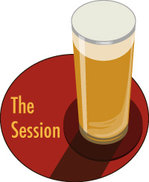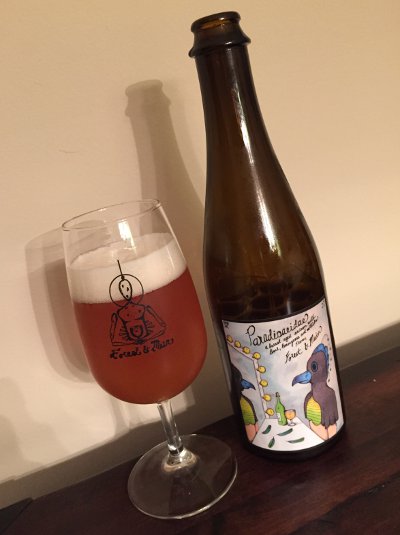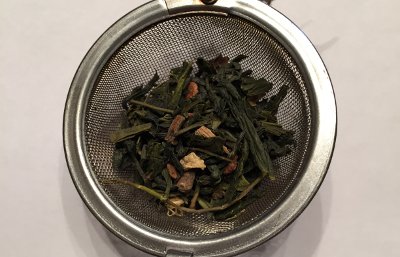 The Session, a.k.a. Beer Blogging Friday, is an opportunity once a month for beer bloggers from around the world to get together and write from their own unique perspective on a single topic. Each month, a different beer blogger hosts the Session, chooses a topic and creates a round-up listing all of the participants, along with a short pithy critique of each entry. You can find more information on The Session on Brookston Beer Bulletin.
The Session, a.k.a. Beer Blogging Friday, is an opportunity once a month for beer bloggers from around the world to get together and write from their own unique perspective on a single topic. Each month, a different beer blogger hosts the Session, chooses a topic and creates a round-up listing all of the participants, along with a short pithy critique of each entry. You can find more information on The Session on Brookston Beer Bulletin.
I’ve sporadically participated in “The Session” many times over the years, but this is the first time I’ve hosted. Many thanks to those who took the time to put together a post on this month’s chosen topic, a “Double Feature”, wherein participants drank two beers, compared and contrasted, and maybe even paired with some form of media for extra credit. Let’s check out your responses:
First up, Sara Q. Thompson takes on two Imperial Stouts made with coffee that were aged between 1.5 and 2 years. Coffee is one of those ingredients that tends to fall off over time, so this is certainly an interesting approach. For the media pairing, it Sara points to the Taster’s Choice Gold Blend saga, a series of flirtatious coffee commercials (And she’s in good company: Stanley Kubrick was apparently fascinated by the storytelling economy in coffee commercials, and would recut them to make them even more concise.)
Next, Sara’s husband Mark Lindner went British, pairing two Samuel Smith Organic beers with the last two episodes of Doctor Who Series 2 [reboot, David Tennant]. I have to say, that pale ale doesn’t look pale at all, and from the sounds of it, it wasn’t particularly fresh, which is a pity. “So the moral, I guess, is old TV shows are OK to visit for either the first time or to revisit, as the case may be, but other than the beers-that-can-be-aged most beers should not be.”
The Beer Nut has some choice words for celebrity chefs and their bumbling attempts at beer tie-ins. “It’s always mediocre, lowest-common-denominator, beer for people who aren’t especially interested in beer.” J’accuse! Will Kevin Dundon’s pair of beers, brewed “round the back of his posh country house hotel”, break down The Beer Nut’s cynicism? Or will they be the same bland, uninspired stuff of most celebrity chef fare? Only one way to find out, and along the way, we’re treated to some thoughts on beer and food pairing as well.
Gary Gillman over at Beer et seq. busts out “two beers, both lagers, yet different as can be.” Unimpressed with each, he takes to blending the two together to see if a more harmonious brew results, always an interesting exercise.
Derrick Peterman at Ramblings of a Beer Runner strains our premise to near its breaking point by drinking a pair of Ciders. Ciders! Actually, I love that he went far afield on this one, and I learned that ciders are more of “a study in subtleties”. Plus, Derrick perfectly captures what I was going for when I chose my topic:
Now don’t get me wrong, I’m all for crystal ball gazing, thinking deeply on esoteric beer concepts, or waxing philosophical on beer culture. But I love his Session topic harks back to an earlier, simpler time of The Session, where the idea was let’s all drink a beer and talk about it. Maybe too many topics only a hard core beer geek could possibly care about, let alone write about, was a big part of why The Session was almost no more.
Indeed, and I’m happy my topic seemed to have the intended effect.
Tom Bedell recalls previous beer duos and then devises some of the most excellent movie pairings for those beers that I’ve seen (certainly the best of this Session!) Filmic choices range from Alfred Hitchcock’s The Trouble With Harry, to Anchorman, Rocky, and even Sophie’s Choice (that last a particularly good choice when rating two great beers). The movie nerd in me adores this post. Well done Tom!
The Brew Site’s Jon Abernathy also picks up on my purpose for the topic, noting recent higher-concept sessions and calling this one a homecoming of sorts. To celebrate, Jon picks up two canned, hop-driven session beers, one a hoppy saison, the other a straight up session IPA. Both sound great!
Sean Inman at Beer Search Party surveys a pair of Victory beers, going for a sorta old-school East Coast IPA battle I guess. I like how Headwaters has morphed from an American Pale Ale to a “Quasi-Session IPA” because that’s basically what a Session IPA is anyway. While he’s at it, he dissects the can designs as well. For the movie pairing, he picks a duo of Steve Jobs bio-picks and laments the lack of available suds at movie theaters (dear Alamo Draft House, if you’re reading, please open theaters in LA and Philadelphia, thank you.)
A Good Beer Blog’s Alan McLeod has done this. He’s done this a lot. Over a decade ago. In fact, he points to a couple of quadruple features and a triple feature before settling on an actual double feature (interesting tidbit, I’m pretty sure that’s my buddy Mike correcting the location of Victory brewing on that IPA post, heh). He mentions these exercises were helpful in trying to “figure out my own lexicon of tastes and descriptions”, and that’s my recollection as well. Bonus: we get another round in Alan’s ongoing feud with Oliver Gray. Delicious.
Finally, your humble host contributed a pair of entries of his own. One welcoming Almanac to Pennsylvania, the other a more harmonious combination of beer and movies, a tribute to Wes Craven. And I’m sure I’ll continue to play with such things in the future, so stay tuned!
Also of note, Boak and Baily didn’t get a chance to put together a post for this session, but as it turns out, they were already embroiled in a series of posts on Bottled Milds that actually seems appropriate. This one even compares a canned mild versus the same beer in a bottle. That is a great double feature, if you ask me!
And that just about covers it. If I missed you or if you want to be a little late to the party, feel free to send your post to me via email at mciocco at gmail dot com or hit me up on twitter @KaedrinBeer (apologies again for the misbehaving comment system I have in this antiquated blog).
Next up for The Session, while not officially announced just yet, appears to be Holiday Beers, hosted by one of the founders of the Session, Jay at Brookston Beer Bulletin.
Update: Added another entry from Beer Search Party…















